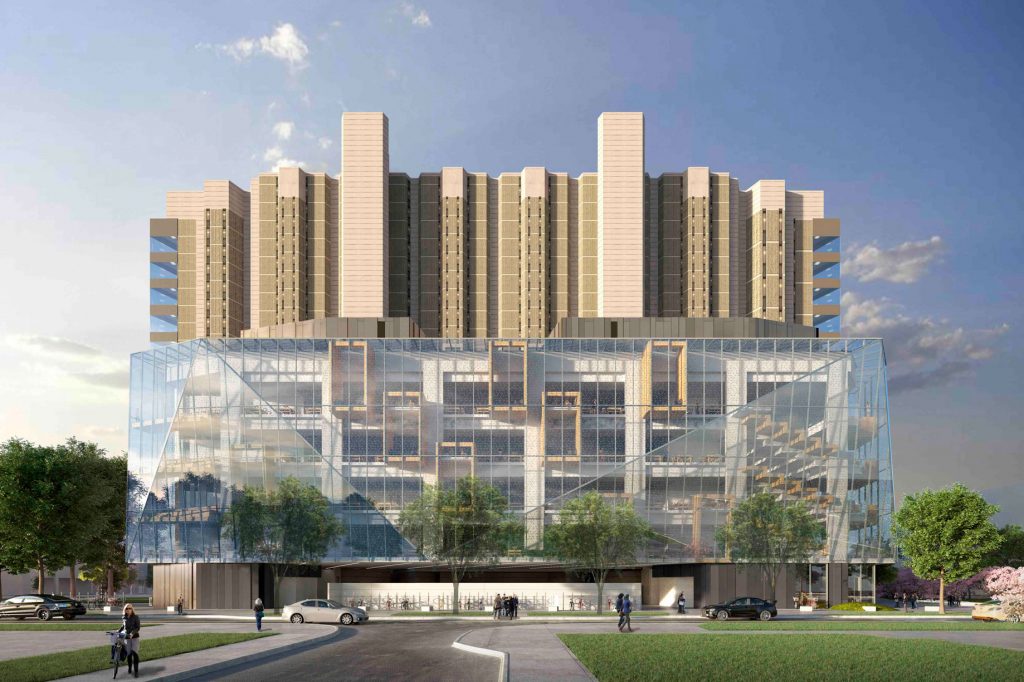Expansion to add study space to face of library

By Ingrid Philipp
The Brutalist concrete façade of the original Robarts Library at the University of Toronto is renowned for its seemingly forbidding entry to any but the most serious scholar.
While the topmost stacks have remained sacred ground to protect books and materials from casual use, the library has become under-graduate and community-friendly. According to Canadian Architect magazine, the intimidating peacock-shaped structure has even hosted filmmakers who needed a prison or UFO setting. As many as 18,000 people have been known to visit the library in a single day.
Even with a multi-year renovation to open up the original structure to daylight and improved study space, student growth has maxed out the capacity for such space. Already Canada’s largest academic library, Robarts and other campus libraries serve a current university population of approximately 90,000 undergraduates and 20,000 post-graduate students.
According to Diamond Schmitt Architect’s associate Aaron Costain, the freestanding addition along the west side of the Robarts site will add 1,200 seats for student study. Costain explains that the 25 per cent increase over Robarts’ current 4,800 seats will include study options ranging from group study tables and rooms to an amphitheatre and individual carrels. Students will be able to use the private rooms for collective work while sharing their computers on a large screen, and to escape to a lounge for more relaxed social space. Even staircases will double as seating, as Diamond Schmitt demonstrates in the Toronto Four Seasons Centre for the Arts.
The new addition along the west side of the Robarts property will have a street level entrance and be open 24 hours a day, seven days a week. The expansion’s wrap-around glass façade with wood accents contains some echoes of the main concrete building, and will connect to the original 14- storey building by a bridge on floors two, three, four, and five.
Unlike the main building, glass will flood the area with light, even as a thematic relationship between the buildings is maintained through the Commons faceted shapes. Rolling blinds will control the amount of window light for both interior and external residents.
Huron-Sussex Residents’ Organization co-president Julie Mathien said that a major concern for the group was the possible effect of the new building’s 24-hour lighting on nearby residents, who live as close as 50 feet away. Because all new developments in the university are brought to the City University Community Liaison Committee headed by Councillor Mike Layton, the residents were able to get the university to mitigate the effect of the lighting.
Even though the residents would have preferred not to have construction, the organization understands the university’s need to serve students. Mathien called the five- to six-year discussions constructive and says, “We can live with the building.”
Costain points to the new University of Ontario Institute of Technology in Oshawa, the Ottawa Public Library, which will have National Archive holdings, and the Gerstein Library at the University of Toronto as proof of the firm’s experience designing libraries. Canadian Architect recently published an illustration of Diamond Schmitt’s library build at Wilfrid Laurier University. Although Laurier is not as large a school as Toronto, a student there explained the importance of library study space in an age when many students choose or are forced to live off campus with several roommates. In a word, they need a quiet place to concentrate.
Today, the University of Toronto can only promise residential housing to first-year students. Consider the current costs of Toronto housing, and the number of students who commute to U of T from other towns and cities, and it becomes even harder to dispute the need for university-based study space.
The new addition should be ready to open by the spring of 2020.
